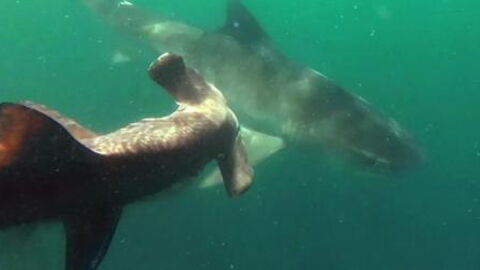The basking shark is particularly known to be solitary. The second largest fish in the world after the whale shark, this animal usually moves through the depths of the oceans in small groups of no more than 7 individuals. And yet, never before seen observations in the North Atlantic have upset this routine, as revealed in a publication published in the Journal of Fish Biology.
Discover our latest podcast
From 1980 to 2013, three researchers surveyed the depths of the ocean, searching for endangered whale species. During this period of observation, the scientists were surprised to witness several unexpected occurrences.
Hundreds of basking sharks sometimes gathered right before their eyes, even forming groups of nearly 1,400 individuals. This behaviour goes against all scientific knowledge of the species, confirmed by 99% of the 10,000 observations made by the trio of specialists, in which groups of sharks did not exceed seven specimens.
Ten exceptional cases
Nevertheless, the researchers were able to observe the grouping of huge colonies of basking sharks ten times. To explain these atypical gatherings, scientists have several theories, related to reproduction, hunting or protection needs.
The most informative event for specialists was a ‘meeting’ of sharks spotted south of New England in 2013.
During this mass reunion, the more than 1,400 individuals were in fact found, most of the time, to be feeding on zooplankton suspended in the waters of the region. Such a swarm would allow sharks, according to the authors of the publication, to take advantage of the ‘inhalation’ hydrodynamic of their brethren, a bit like a bunch of cyclists. This is a way for them to save their precious energy and thus optimise their nutritional intake.
An advantageous underwater perspective
These revelatory observations are most certainly due to their underwater nature. Other images captured from the surface by aerial means cannot be used to link all of the environmental parameters, as the lead author of the work, biologist Leah Crowe of the National Oceanic and Atmospheric Administration's Northeast Fisheries Science Center explains. ‘Observing from the sky is interesting, but that does not tell us much about environmental factors.’ The presence of plankton and its density are notably impossible to evaluate.
In any case, the general public can also contribute to research on these unusual animals, notably by taking part in the participatory science program ‘Spot a Basking Shark,’ a project organised by the Pacific Shark Research Centre, at the Moss Landing Marine Laboratory in California.
By posting any sightings of a basking shark online, everyone can contribute to the preservation of the species, which has been classified as threatened by the United States government since 2010.















